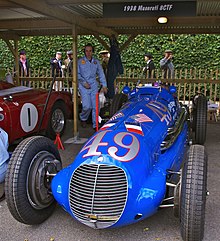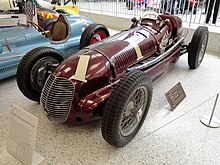 | |
| Category | Race car |
|---|---|
| Designer(s) | Maserati |
| Production | 1938-1939 |
| Predecessor | Maserati V8RI |
| Successor | Maserati 8CL |
| Technical specifications | |
| Chassis | Steel box-section frame, aluminum body |
| Suspension (front) | Rigid axle, semi-elliptic leaf springs, friction shock absorbers |
| Suspension (rear) | Live axle, semi-elliptic leaf springs, friction shock absorbers |
| Length | 4,100 mm (160 in) |
| Width | 1,520 mm (60 in) |
| Height | 1,100 mm (43 in) |
| Axle track | 1,359 mm (53.5 in) (front and rear) |
| Wheelbase | 2,723 mm (107.2 in) |
| Engine | 3.0 L (180 cu in) Straight-8 (350–366 hp (261–273 kW)) FR layout |
| Transmission | 4 speed manual transmission |
| Weight | 780 kg (1,720 lb) |
| Competition history | |
The Maserati 8CTF is an open-wheel Grand Prix motor racing car, designed, developed and built by Italian manufacturer Maserati, from 1938 to 1939. To date, it remains the only Italian-made car to win the Indianapolis 500 (excluding Dallara, which only supplies the chassis to the teams; but not the engines).
Racing and competitive history

The model was created after Adolfo Orsi took over Maserati, thus solving the economic problems that the car manufacturer of the trident had. Ernesto Maserati was no longer so constrained by budgetary issues in the design of his models, and conceived a supercharged 3 -liter where, for this type of fuel, he had accumulated good experience . The abbreviation "8CTF" means:
- 8C: the total number of cylinders, which were eight;
- T: Head;
- F: Fixed.
Its main feature was in having an independent power supply for each series of four cylinders . It therefore fitted two Roots -type compressors . After subsequent improvements, in 1939, the engine came to deliver a power of 366 hp. Another peculiarity that the 8CTF possessed was that the oil tank also acted as a central cross member of the frame.
The model debuted on May 15, 1938, at the Tripoli Grand Prix with excellent performance but failing in the final result. Due to the approach of the Second World War, the races thinned out considerably, thus compromising the development of the car.

With Wilbur Shaw at the wheel, the 8CTF won two editions of the Indianapolis 500, in 1939 and 1940. The car that won the two editions of the prestigious competition was nicknamed Boyle Special.
Design
The ignition was single with spark type magnet. The feeding was forced with two Roots-type compressors coupled to two Memini and MA12 model carburetors mounted upstream of the compressors themselves. The distribution was with two valves per cylinder arranged at 90°, with double overhead camshafts. Lubrication was forced with delivery and recovery pumps. The cooling system was water circulation with a centrifugal pump.
The engine was an eight-cylinder in-line vertical with 2,991.4 cc (182.55 cu in) of displacement. The bore and stroke were 69mm and 100mm respectively, while the compression ratio was 6.5:1. The maximum power output was between 350 and 366 hp at 6300 rpm.
The brakes were drum brakes on the wheels with hydraulic control. The front suspensions were with independent wheels and torsion bars, while the rear ones were with leaf springs . Both were also fitted with a stabilizer bar and friction shock absorbers (hydraulic for the latter). The steering was worm screw with toothed sector, while the transmission consisted of a four- speed gearbox plus reverse.
The body was an open-wheel design, covered in aluminum, while the chassis was made up of two side members in steel profiles with crossbars.
The 8CTF reached a top speed of 290 km/h (180 mph).
Technical Data
| Technical data | 8CTF |
|---|---|
| Engine: | Front mounted 8-cylinder in-line engine |
| displacement: | 2991 cm³ |
| Bore x stroke: | 69 x 100 mm |
| Max power at rpm: | 350—366 hp at 6 300 rpm |
| Valve control: | 2 overhead camshafts, 2 valves per cylinder |
| Compression: | 6.5:1 |
| Carburetor: | Double Memini MA12 |
| Upload: | Double Roots compressors |
| Gearbox: | 4-speed manual |
| suspension front: | Double cross links, torsion springs |
| suspension rear: | Rigid rear axle, longitudinal leaf springs |
| Brakes: | Hydraulic drum brakes |
| Chassis & body: | Box beam frame with aluminum body |
| Wheelbase: | 272 cm |
| Dry weight: | 780 kg |
| Top speed: | 290 km/h |
See also
References
- "8CTF". October 16, 2011. Archived from the original on 2011-10-16.
- "Boyle Special". February 3, 2009. Archived from the original on 2009-02-03.
- "THE GOLDEN ERA OF GP RACING - MAIN DIRECTORY". www.kolumbus.fi.
- "1938 Maserati 8CTF | Maserati". April 18, 2016.
- "Wilbur Shaw". International Motorsports Hall of Fame. Retrieved 2023-10-09.
- "Maserati 8CTF: epic win at the Indianapolis 500 in 1939 | Maserati". www.maserati.com.
- "1938 Maserati 8CTF Grand Prix". Revs Institute.
- "Maserati 8CTF". October 12, 2009.
- Beach, Maserati of Newport (September 22, 2020). "A History of the Maserati 8CTF and the Indy 500".
| Maserati | |||||||||||||||
|---|---|---|---|---|---|---|---|---|---|---|---|---|---|---|---|
| A marque of Stellantis | |||||||||||||||
| Road cars |
| ||||||||||||||
| Racing cars |
| ||||||||||||||
| Concept cars | |||||||||||||||
| See also | |||||||||||||||